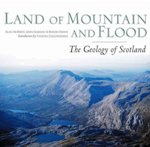Land of Mountain and Flood – The geology and landforms of Scotland

Alan McKirdy, John Gordon & Roger Crofts. Introduction by Vanessa Collingridge
Published by: Birlinn Ltd, in association with Scottish Natural Heritage
Publication date: April 2007
ISBN: 978-1-84158-357-0 (hbk)
List price: £30.00
400 pp
www.birlinn.co.uk
Land of the mountain and the flood,
Land of my sires! what mortal hand
Can e'er untie the filial band,
That knits me to thy rugged strand!
The title of this handsome volume echoes Sir Walter Scott's
Lay of the Last Minstrel, and it is odd that a book so obviously produced by Scots for Scots (celebrity Introduction by broadcaster unknown outside Scotland; subsidy from state bodies; frequent references to the culture of Caledonia stern and wild, etc.) does not quote the stirring original (above) on the title page, alongside Hutton and Geikie's more prosaic epigraphs.
Still, let us not be churlish - it is hard to praise this book enough for its satisfying melding of the geological history and structure of Scotland with human prehistory, the history of geological science, and pressing societal concerns such as energy (fossil and renewable) and the whisky, brewing and extractive industries.
The first chapter, entitled Geology Enriches All of Our Lives, attempts a comprehensive PR job on the whole of Earth science, its applications and ramifications - even introducing concepts of geodiversity to what one must only assume is intended to be an unsuspecting audience. With its second chapter the book then launches into foundation course mode, and from then on we are into "textbook lite" territory. How the Earth Works places heavy emphasis on the role of Scottish pioneers in elucidating much of the Earth story, before leading into Scotland's Journey Across the Globe, which begins a stratigraphic and structural trek from the Lewisian through the Torridonian, Dalradian, Cambrian, and – well, you know the rest. But all this information is well conveyed, with colour diagrams and photographs (some of whose reproduction is muddy and would disappoint me had I been the photographer). There are also many tinted boxes for side issues to help the reader along.
Chapter 4 describes how the present landscape was sculpted and is mostly about glacial geomorphology. Chapter 5 discusses Future Landscapes and asks what might happen to Scotland in ages to come. There is a useful appendix suggesting places to visit.
If I have a problem with the book, it is that it's far too cheap! Thanks to SNH and the Scottish Arts Council, both of whom have subsidised the volume directly and in kind, this book is quite amazing value for money - you can buy it for a mere £16 on Amazon. I find this triggers a whole range of reactions. You can see it as making geology accessible and attractive to all. It's a fair point that, as a fairly blatant piece of pro-geo propaganda, it might be unwise to make it too expensive. Or one could see it as a self-indulgent excursion into vanity publishing on the public purse. As I believe in the first as strongly as I disapprove of the last, I find myself in two minds. But there can be no doubt that McKirdy and co-authors have produced a worthy addition to the popular literature on the geological heritage of the land of their sires, and I congratulate them on it. I just hope that people read it and do not let it languish on their coffee tables under TV Quick.
Ted Nield